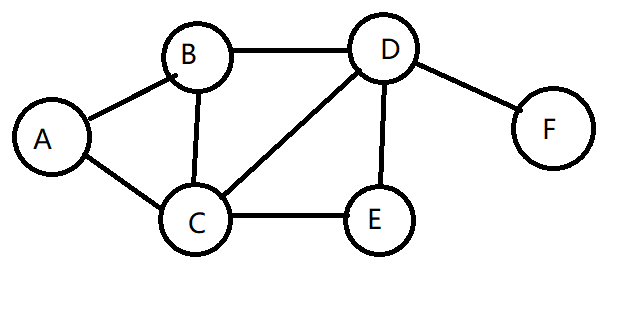版权声明:本文为博主原创文章,遵循 CC 4.0 BY-SA 版权协议,转载请附上原文出处链接和本声明。
前言
为什么要使用C语言
因为c语言中基本没有数据结构, 所有的数据结构都需要自己来定义, 看一个人有没有真正的理解这个算法, 那么用C语言能写出来就算是真正的明白了这个算法的过程, 所以c语言是检验技术的一个有力的方法
为什么要弄明白这些算法
我的老师王老师说过, 会底层的才是人才, 应用都是最基础的, 都是小儿科 核心思想在别人那里想给你用就给你用, 不给你用你也没有办法.
简要说明
BFS和DFS是数据结构中图的遍历中使用的算法, 跟二叉树的遍历有着异曲同工之妙.
BFS
BFS, Breadth First Search, 广度优先遍历, 遍历思路为: 从最开始遍历的结点开始, 按顺序一次找到所有的距离当前结点最近的结点, 知道所有的结点都被遍历完成.
这样的话我们可以用一个队列的数据结构来实现这个BFS遍历方法
队列 -> BFS
- 将开始访问的结点放入队头中
- 将队头的临接结点放入队列中
- 开始的结点pop弹出
- 重复2, 3直到队列为空
- 注意: 每次只pop弹出一个元素, 放入所有的邻接结点, 队列中的元素不重复(逻辑)
DFS
DFS, Deepth First Search, 深度优先遍历, 遍历思路为: 从最开始遍历的结点, 一条路走到黑, 知道五路可走, 再返回一个有路的结点, 最新的路(也就是访问未访问的结点), 直到所有的结点都被访问/(遍历)过
与BFS相似, 我们可以用一个栈的数据结构来实现这个DFS算法
栈 -> DFS
- 将开始访问的结点的放入栈中
- 将栈中的一个元素pop弹出,
- 当前弹出的元素的邻接结点全部放入栈中
- 重复2, 3, 直到栈为空
- 注意: 每次在栈中只pop一个元素, 放入的不一定是一个, 栈中的元素不重复(逻辑).
代码实现
测试图

代码+测试主方法
/*
***********************************************************************
******************** Breadth First Search and *************************
******************** Deepth First Search ******************************
******************** Author : Master_Joe Guangtong*********************
***********************************************************************
*/
#include <stdio.h>
#include <stdlib.h>
// set length of stack or queue
#define MAX_SIZE 32
// Stack data structure
typedef struct stack {
int length;
char datas[MAX_SIZE];
} Stack;
// Queue data structure
typedef struct queue {
int front;
int rear;
char datas[MAX_SIZE];
} Queue;
// Graph node data structure
typedef struct node {
char data;
struct node* next;
} Node;
// Graph data structure
typedef struct graph {
int numNodes;
// adjacency list
Node* adjLists[128];
int visited[128];
} Graph;
/**
* Create a stack with no element
*/
Stack* create_stack() {
return malloc(sizeof(Stack));
}
/**
* Create a queue with no elment
*/
Queue* create_queue() {
return malloc(sizeof(Queue));
}
/**
* Create an node with a element
*/
Node* create_node(char value) {
Node* node = malloc(sizeof(Node));
node -> data = value;
node -> next = NULL;
return node;
}
/**
* Create Graph with number of vertices
* @param n number of vertices
*/
Graph* create_graph(int n) {
Graph* graph = malloc(sizeof(Graph));
graph -> numNodes = n;
/*
It is not necessary
graph -> adjLists = malloc(n * sizeof(Node));
graph -> visited = malloc(n * sizeof(Node));
int i;
for (i = 0; i < n; i++) {
// No Nodes, no visiting
graph -> adjLists[i] = NULL;
graph -> visited[i] = 0;
}
*/
return graph;
}
/**
* Add edges to a graph
* @param graph the specified graph to add
* @param start start node in an edge
* @param end end node in an edge
*/
void add_edge(Graph* graph, char start, char end) {
// Add edge from start to end
Node* node = create_node(end);
node -> next = graph -> adjLists[start];
graph -> adjLists[start] = node;
// Add edge from end to start
node = create_node(start);
node -> next = graph -> adjLists[end];
graph -> adjLists[end] = node;
}
/**
* insert a value into a Stack
* @param stack which stack you will insert into
* @param value what you want to insert
*/
void push_s(Stack* stack, char value) {
if (stack -> length != MAX_SIZE) {
stack -> datas[stack -> length++] = value;
} else {
printf("stack overflow!!");
}
}
/**
* decide if a queue is full
* @return {@code 1} is full <br>
* {@code 0} is not full
*/
int is_full_q(Queue* queue) {
if (queue -> rear == MAX_SIZE - 1) {
return 1;
}
else {
return 0;
}
}
/**
* decide if a queue is empty
* @return {@code 1} is empty
* {@code 0} is not empty
*/
int is_empty_q(Queue* queue) {
if (queue -> front == queue -> rear) {
return 1;
}
else {
return 0;
}
}
/**
* decide if a stack is empty
* @return {@code 1} is empty
* {@code 0} is not empty
*/
int is_empty_s(Stack* stack) {
if (stack -> length == 0) {
return 1;
}
else {
return 0;
}
}
/**
* insert a value into a Queue
* @param queue which queue you will insert into
* @param value what you will insert
*/
void push_q(Queue* queue, char value) {
if (!is_full_q(queue)) {
queue -> datas[queue -> rear++] = value;
} else {
printf("Queue is full");
}
}
/**
* pop element from first
* @param queue where you will pop
* @return the first element
*/
char pop_q(Queue* queue) {
if (queue -> front != queue -> rear) {
return queue -> datas[queue -> front++];
} else {
return -1;
}
}
/**
* pop the end element of a Stack
* @param stack you will get its last element
* @return the last element of {@code stakc}
*/
char pop_s(Stack* stack) {
if (stack -> length != 0) {
return stack -> datas[--stack -> length];
} else {
return -1;
}
}
/**
* Breadth first search
* @param graph specified graph made bfs
* @param start start vertex in bfs
*/
void bfs(Graph* graph, char start) {
Queue* queue = create_queue();
graph -> visited[start] = 1;
push_q(queue, start);
while(!is_empty_q(queue)) {
char current = pop_q(queue);
printf("%c\n", current);
Node* temp = graph -> adjLists[current];
while (temp != NULL) {
// Traverse the whole graph
char adjD = temp -> data;
if (graph -> visited[adjD] == 0) {
graph -> visited[adjD] = 1;
push_q(queue, adjD);
}
temp = temp -> next;
}
}
}
/**
* Deepth first search
* @param graph specified graph made bfs
* @param start start vertex in bfs
*/
void dfs(Graph* graph, char start) {
// Queue* queue = create_queue();
Stack* stack = create_stack();
graph -> visited[start] = 1;
push_s(stack, start);
while(!is_empty_s(stack)) {
char current = pop_s(stack);
printf("%c\n", current);
Node* temp = graph -> adjLists[current];
while (temp != NULL) {
// Traverse the whole graph
int adjD = temp -> data;
if (graph -> visited[adjD] == 0) {
graph -> visited[adjD] = 1;
push_s(stack, adjD);
}
temp = temp -> next;
}
}
}
/*
*/
int main() {
Graph* graph = create_graph(5);
add_edge(graph, 'A', 'B');
add_edge(graph, 'A', 'C');
add_edge(graph, 'B', 'C');
add_edge(graph, 'B', 'D');
add_edge(graph, 'C', 'D');
add_edge(graph, 'C', 'E');
add_edge(graph, 'D', 'E');
add_edge(graph, 'D', 'F');
bfs(graph, 'B');
return 0;
}